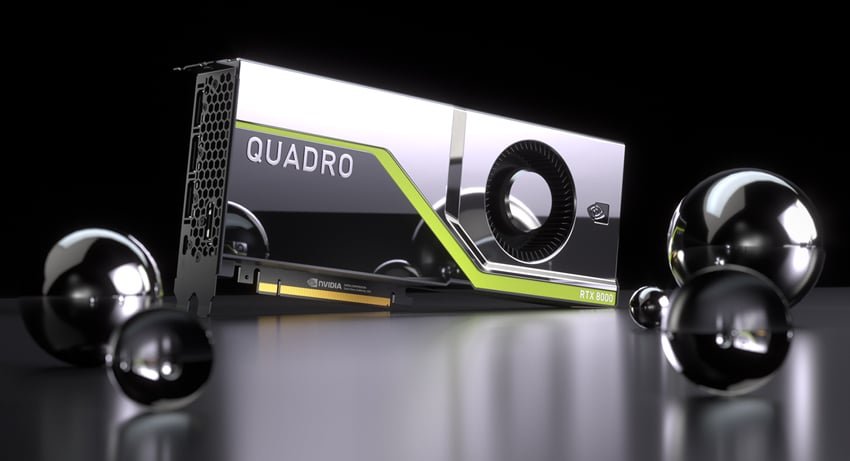 This year at SIGGRAPH, NVIDIA made several announcements. These announcements include a new Graphics architecture, Turing, as well as the world’s first ray-tracing GPU, the Quadro RTX. NVIDIA is happy to announced endorsements from some of the top graphics software companies and it has made its Material Definition Language SDK available as open source.
This year at SIGGRAPH, NVIDIA made several announcements. These announcements include a new Graphics architecture, Turing, as well as the world’s first ray-tracing GPU, the Quadro RTX. NVIDIA is happy to announced endorsements from some of the top graphics software companies and it has made its Material Definition Language SDK available as open source.
This year at SIGGRAPH, NVIDIA made several announcements. These announcements include a new Graphics architecture, Turing, as well as the world’s first ray-tracing GPU, the Quadro RTX. NVIDIA is happy to announced endorsements from some of the top graphics software companies and it has made its Material Definition Language SDK available as open source.

With its new architecture, Turing, NVIDIA is making the bold claim that it has reinvented computer graphics. The company is going on to call Turning the greatest technological leap in graphics since the invention of the CUDA GPU in 2006. Sounds promising, so what is it? NVIDIA states that Turing has RT cores for accelerating ray traces and Tensor Cores for AI inferencing. When combined this makes real-time ray tracing possible for the first time.
The visual effects industry has exploded in the last decade or so, being an estimated $250 billion industry now. The new Turing technology can capitalize on this with promises of a new generation of hybrid rendering that enables cinematic-quality interactive experiences, amazing new effects powered by neural networks and fluid interactivity on highly complex models.
The Turing architecture is a result of over 10,000 engineering-years of effort. The RT Cores are stated as accelerating the computation of how light and sound travel in 3D environments at up to 10 GigaRays a second. The other cores leveraged, Tensor, are stated to accelerate deep learning training and inferencing, providing up to 500 trillion tensor operations a second. This combination can simulate the physical world at 6x the speed of the previous Pascal generation.
The first product to feature the new Turing technology is the NVIDIA Quadro RTX GPUs featuring the NVIDIA Quadro RTX 8000, Quadro RTX 6000, and Quadro RTX 5000 GPUs as well as a Quadro RTX server. As above, these new GPUs are designed to unleash new potential when rendering photorealistic scenes in real-time. These GPUs are aimed at high end design such as film and video content as well as design in automotive and architectural fields.
Features and benefits include:
- New RT Cores to enable real-time ray tracing of objects and environments with physically accurate shadows, reflections, refractions and global illumination.
- Turing Tensor Cores to accelerate deep neural network training and inference, which are critical to powering AI-enhanced rendering, products and services.
- New Turing Streaming Multiprocessor architecture, featuring up to 4,608 CUDA cores, delivers up to 16 trillion floating point operations in parallel with 16 trillion integer operations per second to accelerate complex simulation of real-world physics.
- Advanced programmable shading technologies to improve the performance of complex visual effects and graphics-intensive experiences.
- First implementation of ultra-fast Samsung 16Gb GDDR6 memory to support more complex designs, massive architectural datasets, 8K movie content and more.
- NVIDIA NVLink to combine two GPUs with a high-speed link to scale memory capacity up to 96GB and drive higher performance with up to 100GB/s of data transfer.
- Hardware support for USB Type-C and VirtualLink, a new open industry standard being developed to meet the power, display and bandwidth demands of next-generation VR headsets through a single USB-C connector.
- New and enhanced technologies to improve performance of VR applications, including Variable Rate Shading, Multi-View Rendering and VRWorks Audio.
The Quadro RTX Server will be a combination of the new RTX GPUs and Quadro Infinity software. The server, through the new software, will allow several users to access a single GPU for their virtual workstations. NVIDIA states that the new RTX Server can be used for small installations all the way up to the largest data centers.
Availability and Pricing
Quadro GPUs based on Turing will be initially available in the fourth quarter.
- Quadro RTX 8000 with 48GB memory: $10,000 estimated street price
- Quadro RTX 6000 with 24GB memory: $6,300 ESP
- Quadro RTX 5000 with 16GB memory: $2,300 ESP
Sign up for the StorageReview newsletter
